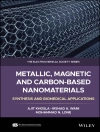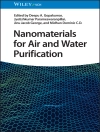Actuators are devices that convert electrical energy into
mechanical work, traditionally used in electrical, pneumatic and
hydraulic systems. As the demand for actuator technologies grows in
biomedical, prosthetic and orthotic applications, there is an
increasing need for complex and sophisticated products that perform
efficiently also when scaled to micro and nano domains.
Providing a comprehensive overview of actuators for novel
applications, this excellent book:
* Presents a mechatronic approach to the design, control and
integration of a range of technologies covering piezoelectric
actuators, shape memory actuators, electro-active polymers,
magnetostrictive actuators and electro- and magnetorheological
actuators.
* Examines the characteristics and performance of emerging
actuators upon scaling to micro and nano domains.
* Assesses the relative merits of each actuator technology and
outlines prospective application fields.
Offering a detailed analysis on current advances in the field, this
publication will appeal to practising electrical and electronics
engineers developing novel actuator systems. Mechanical and
automation engineers, computer scientists and researchers will also
find this a useful resource.
Mục lục
Foreword.
Preface.
List of Figures.
List of Tables.
1 Actuators in motion control systems: mechatronics.
1.1 What is an actuator?
1.2 Transducing materials as a basis for actuator design.
1.3 The role of the actuator in a control system: sensing,
processing and acting.
1.4 What is mechatronics? Principles and biomimesis.
1.5 Concomitant actuation and sensing: smart structures.
1.6 Figures of merit of actuator technologies.
1.7 A classification of actuator technologies.
1.8 Emerging versus traditional actuator technologies.
1.9 Scope of the book: emerging actuators.
1.10 Other actuator technologies.
2 Piezoelectric actuators.
2.1 Piezoelectricity and piezoelectric materials.
2.2 Constitutive equations of piezoelectric materials.
2.3 Resonant piezoelectric actuators.
2.4 Nonresonant piezoelectric actuators.7
2.5 Control aspects of piezoelectric motors.
2.6 Figures of merit of piezoelectric actuators.
2.7 Applications.
3 Shape Memory Actuators (SMAs).
3.1 Shape memory alloys.
3.2 Design of shape memory actuators.
3.3 Control of SMAs.
3.4 Figures of merit of shape memory actuators.
3.5 Applications.
4 Electroactive polymer actuators (EAPs).
4.1 Principles.
4.2 Design issues.
4.3 Control of EAPs.
4.4 Figures of merit of EAPs.
4.5 Applications.
5 Magnetostrictive actuators (MSs).
5.1 Principles of magnetostriction.
5.2 Magnetostrictive materials: giant magnetostriction.
5.3 Design of magnetostrictive actuators.
5.4 Control of magnetostrictive actuators: vibration
absorption.
5.5 Figures of merit of MS actuators.
5.6 Applications.
6 Electro- and magnetorheological actuators (ERFs,
MRFs).
6.1 Active rheology: transducing materials.
6.2 Mechatronic design concepts.
6.3 Control of ERF and MRF.
6.4 Figures of merit of ER and MR devices.
6.5 Applications.
7 Summary, conclusions and outlook.
7.1 Brief summary.
7.2 Comparative position of emerging actuators.
7.3 Research trends and application trends.
Bibliography.
Index.
Giới thiệu về tác giả
José L. Pons, Research Manager, Instituto de Automática Industrial, Consejo Superior de Investigaciones Científicas, Carretera de Campo Real, La Poveda, Arganda del Rey, MADRID, ESPAÑA












